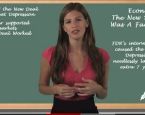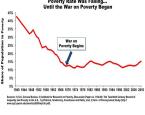Tag Archives : free markets
The New Deal Was A Failure: Hoover and FDR Prolonged the Great Depression with Big Government
This mini-documentary from the Center for Freedom and Prosperity Foundation explains how the statist policies of Presidents Hoover and Roosevelt lengthened and deepened the Great Depression. The video also briefly explains how reductions in the burden of government spending helped the economy recover from a deep recession after World War I and to grow after World War II.
read more...China’s Economic Model Is Superior…if You Think U.S. Living Standards Should Drop by 80 Percent
I’m glad that China has taken some steps away from communism. According to Economic Freedom of the World, China was one of 10-worst nations for economic liberty back in 1980 and they’ve since climbed to 92nd place out of 141 nations. I’ve even offered a small bit of praise for China’s shift to a more […]
read more...Is Ireland’s Michael Higgins an Economic Illiterate or a Cynical Hack
I’ve always been proud of my Irish heritage, but now I’m having to reconsider. As is so often the case when something goes awry, the blame belongs to a politician (this Craig Ferguson joke is right on the mark). Michael Higgins, the President-Elect of Ireland, has lived a very comfortable life sucking on the government […]
read more...New Video Has Important Message: Freedom and Prosperity vs. Big Government and Stagnation
The folks from the Koch Institute put together a great video a couple of months ago looking at why some nations are rich and others are poor. That video looked at the relationship between economic freedom and various indices that measure quality of life. Not surprisingly, free markets and small government lead to better results. […]
read more...The Danish Dr.-Jekyll-Mr.-Hyde Paradox and Wagner’s Law
What nation is a role model for economic reformers? I’ve certainly cited Hong Kong as an example, but I’ve also explained that we can learn lessons – at least on certain issues – from nations such as Sweden, Australia, Canada, and the Baltics. Today, let’s talk about the curious case of Denmark, which is a […]
read more...Free Markets, Not Redistribution, Is Best Way to Reduce Poverty
The so-called War on Poverty has failed. Making government bigger and creating more federal redistribution programs has been bad news for taxpayers. But the welfare state also has been a disaster for the less fortunate, creating a flypaper effect that makes it difficult for people to lead independent and self-reliant lives. This Center for Freedom and Prosperity Foundation video shows how the poverty rate was falling after World War II — but then stagnated once the federal government got involved.
read more...New “Economics 101” Video from CF&P Exposes Failure of the War on Poverty, Calls for Free Markets for Upward Mobility
The latest “Economics 101” video released today by the Center for Freedom and Prosperity Foundation (CF&P), narrated by Hadley Heath of the Independent Women’s Forum, calls for restoring economic freedom to reduce poverty. Entitled, “Free Markets, Not Redistribution, Is Best Way to Reduce Poverty,” the video puts poverty in perspective and shows how government redistribution programs perpetuate rather than alleviate the problem.
read more...New Rankings from Economic Freedom of the World Reveal Dismal Impact of Bush-Obama Statism
The 2011 edition of Economic Freedom of the World, published by Canada’s Fraser Institute (with help from groups like Cato), has been released. Covering data through 2009, the new report provides damning evidence of the negative impact of the Bush-Obama policies of bigger government and more intervention. Here’s a relevant passage from the Executive Summary. […]
read more...Rich People Should Help the Poor by…Making Smart Investments and Earning Big Profits
There’s a very provocative article on the New York Times website that criticizes Steve Jobs for his supposed lack of charitable giving. Surprisingly, there is one thing that Mr. Jobs is not, at least not yet: a prominent philanthropist. Despite accumulating an estimated $8.3 billion fortune through his holdings in Apple and a 7.4 percent stake […]
read more...Bacon, Duct Tape, and the Free Market
It’s hard to imagine how we would get through life without necessities like bacon and duct tape. But have you ever thought about how the free market gives you so much for so little? Here’s a video that should be mandatory viewing in Washington. Too bad politicians didn’t watch it before imposing government-run healthcare. And […]
read more...



